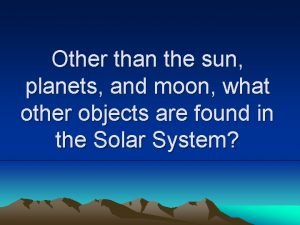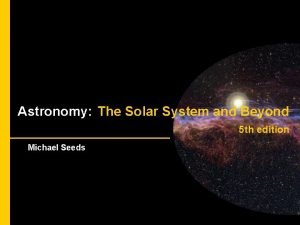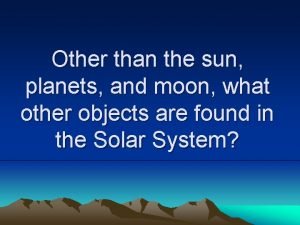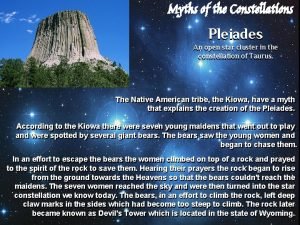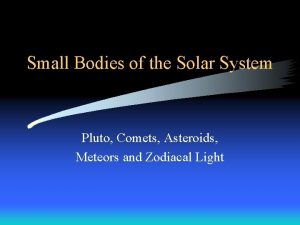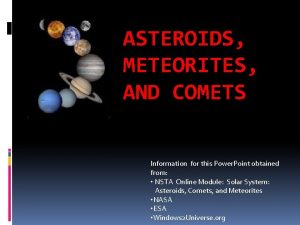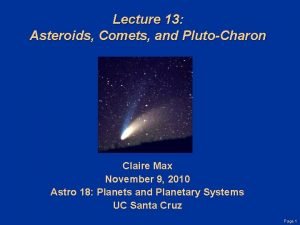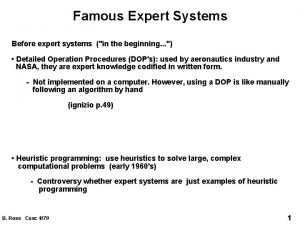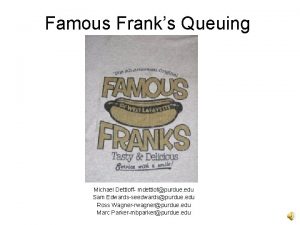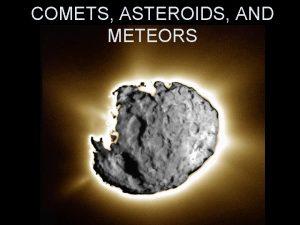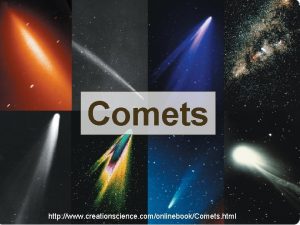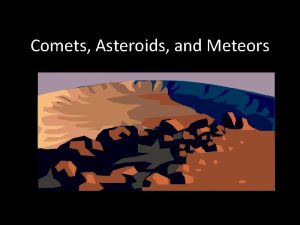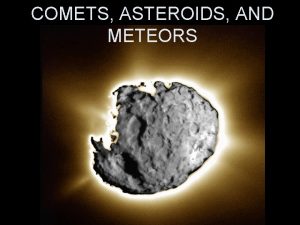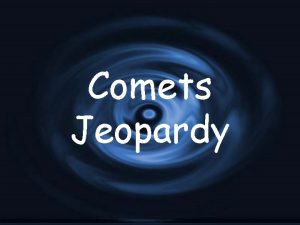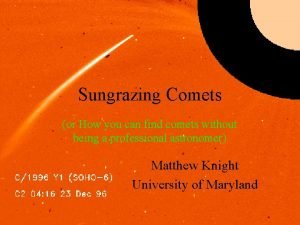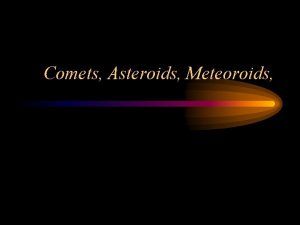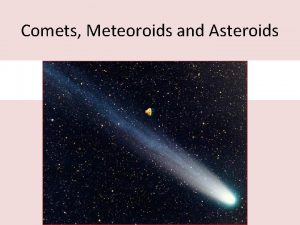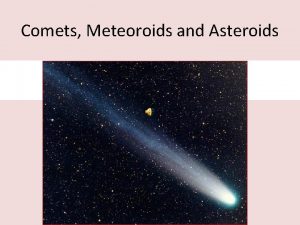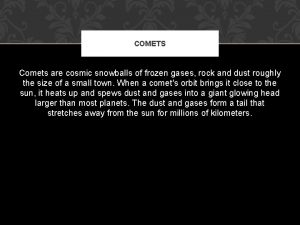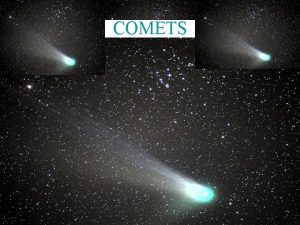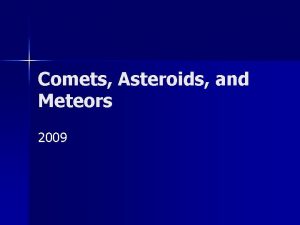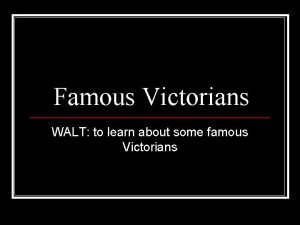Some pictures of famous comets Comets from the















































































- Slides: 79


Some pictures of famous comets:




Comets - from the Greek kome, meaning “hair”. Only visible when far from the Sun due to reflected light. As they near the Sun, comets emit light of their own.


Comets have highly elliptical orbits. They develop tails as icy matter in the comet becomes heated and sublimes away. A comet’s tail always points away from the Sun.




If a comet survives its close approach to the Sun (some are completely broken apart or crash into the Sun), it continues to extreme distances from the Sun.

The orbits extend far beyond Pluto, perhaps 50, 000 A. U. ’s. Most take hundreds of thousands to millions of years to orbit the Sun. A “short” period comet is a comet with an orbit less than 200 years.


Comets orbit at all inclinations and orientations, both prograde and retrograde. For each comet we see, there are many more so far from the Sun that they are invisible from Earth.

There may be a huge cloud of comets, beyond the orbit of Pluto, called the Oort Cloud. Most comets spend their entire lives in the cloud.

Occasionally the gravity of a passing star “kicks” a comet into an orbit that brings it close to the Sun.

Halley’s Comet Edmund Halley realized that this comet visits every 76 years and predicted its reappearance in 1758.


He did not live to see his prediction proved correct, but the comet was named in his honor. Sightings of Halley’s comet have been traced back to 240 B. C.

The tail of Halley’s comet can reach almost one A. U. in length, stretching tens of degrees across the sky. The 1986 visit was not good for viewing from Earth, but spacecraft did visit it at this time.





The main solid body of a comet is called the nucleus. It is typically only a few kilometers in length.


The Sun’s heat causes the nucleus to form a diffuse coma of dust and evaporated gas. The coma can measure as much as 100, 000 km in diameter (almost as large as Jupiter).

An invisible hydrogen envelope surrounds the coma and stretches millions of km into space.


The tail stretches almost an A. U. The tail and the coma are the only parts visible from Earth. Most of a comet’s light comes from the coma.

Comets are of two types, distinguished by their tails: Type I and Type II.

Type I (ion, or plasma) tails: very straight, made of glowing, linear streams.

Type II (dust) tails: broad, diffuse, gently curved, only reflects light.

Many comets have both types mixed. Comet Kahoutek (1975) was a highly publicized flop because its large dust tail scattered the light from its ion tail.





The tail of a comet always is directed away from the Sun as it is produced by the solar winds. Ions in the type I tail are more influenced by the solar winds, so they are always directed in a straight line from the Sun.

The dust particles of the type II tail are heavier, so they have more of a tendency to follow the comet’s orbit, making them slightly curved.

In 1986, a number of spacecraft visited Halley’s comet. Vega 2(Russian) went through the tail, and Giotto(European) moved within 600 km of the nucleus(this damaged Giotto’s camera). They each imaged Halley’s nucleus.





Halley’s nucleus is irregular, potato-shaped and is almost jet black. Jets of matter are expelled from small areas on the sunlit side. These jets are what causes the nucleus to rotate once every 53 hours.


Comets have masses 15 ranging from 10 to 19 10 g (much like small asteroids), but a comet’s mass decreases over time.

Comets that move within 1 A. U. of the Sun typically lose 107 grams of material every second. That is a loss of 10 tons of cometary material for every second the comet spends near the Sun.

Halley’s comet will be gone in about 40, 000 years.

Sun-grazing comets may break apart when close to the Sun or may even plunge into the Sun.








Cometary nuclei are believed to be composed of dust particles trapped within a mixture of methane, ammonia, and ordinary water ice. “Dirty snowballs” is the term coined by comet expert Fred Whipple.


Fred Whipple also said, “Comets are like cats, they both have tails, and they do whatever they want!”










Eugene Shoemaker's passion was Astrogeology. He dreamed of going to the Moon. Credited with inventing the branch of Astrogeology within the U. S. Geological Survey, his contributions to the field and the study of impact craters, lunar science, asteroids, and comets are legendary. Though his own career as an astronaut/geologist was sidelined by a health problem, he helped train the Apollo astronauts in geology and the investigation of the lunar surface.

Seen here at Meteor Crater, Arizona in the mid 1960 s, Shoemaker was killed in a tragic car accident in July 1997. He is survived by his wife and professional colleague, Carolyn, and children. In a fitting tribute conceived by a former student, Eugene Shoemaker's ashes were placed on-board the Lunar Prospector spacecraft which has now successfully reached a polar mapping orbit around the Moon. After completing its scientific mission, the spacecraft will ultimately impact the lunar surface.

The Lunar Prospector crashed to the Moon’s surface in late 1999.

Gene Shoemaker traveled to the Moon as he wished. He ultimately became what he had spent his life studying, a crater.




 Difference between comets and asteroids and meteors
Difference between comets and asteroids and meteors Properties of comets
Properties of comets Asteroids meteors and comets worksheet
Asteroids meteors and comets worksheet Physical properties of comets
Physical properties of comets Myths about comets
Myths about comets Comets asteroids
Comets asteroids Difference between comets and asteroids and meteors
Difference between comets and asteroids and meteors A rocky leftover planetesimal orbiting the sun is
A rocky leftover planetesimal orbiting the sun is Universal pictures columbia pictures
Universal pictures columbia pictures Columbia pictures 20th century fox paramount pictures
Columbia pictures 20th century fox paramount pictures They say sometimes you win some
They say sometimes you win some Some trust in horses
Some trust in horses Ice cream countable or uncountable
Ice cream countable or uncountable Force and motion
Force and motion They say it only takes a little faith to move a mountain
They say it only takes a little faith to move a mountain Some say the world will end in fire some say in ice
Some say the world will end in fire some say in ice Fire and ice diamante poem
Fire and ice diamante poem Từ ngữ thể hiện lòng nhân hậu
Từ ngữ thể hiện lòng nhân hậu Bổ thể
Bổ thể Tư thế ngồi viết
Tư thế ngồi viết Ví dụ về giọng cùng tên
Ví dụ về giọng cùng tên Thơ thất ngôn tứ tuyệt đường luật
Thơ thất ngôn tứ tuyệt đường luật Alleluia hat len nguoi oi
Alleluia hat len nguoi oi Khi nào hổ con có thể sống độc lập
Khi nào hổ con có thể sống độc lập đại từ thay thế
đại từ thay thế Diễn thế sinh thái là
Diễn thế sinh thái là Vẽ hình chiếu vuông góc của vật thể sau
Vẽ hình chiếu vuông góc của vật thể sau Phép trừ bù
Phép trừ bù Công thức tiính động năng
Công thức tiính động năng Tỉ lệ cơ thể trẻ em
Tỉ lệ cơ thể trẻ em Thế nào là mạng điện lắp đặt kiểu nổi
Thế nào là mạng điện lắp đặt kiểu nổi Lời thề hippocrates
Lời thề hippocrates Vẽ hình chiếu đứng bằng cạnh của vật thể
Vẽ hình chiếu đứng bằng cạnh của vật thể Quá trình desamine hóa có thể tạo ra
Quá trình desamine hóa có thể tạo ra Các môn thể thao bắt đầu bằng tiếng nhảy
Các môn thể thao bắt đầu bằng tiếng nhảy Hát kết hợp bộ gõ cơ thể
Hát kết hợp bộ gõ cơ thể Sự nuôi và dạy con của hổ
Sự nuôi và dạy con của hổ Các loại đột biến cấu trúc nhiễm sắc thể
Các loại đột biến cấu trúc nhiễm sắc thể Biện pháp chống mỏi cơ
Biện pháp chống mỏi cơ Trời xanh đây là của chúng ta thể thơ
Trời xanh đây là của chúng ta thể thơ Phản ứng thế ankan
Phản ứng thế ankan Gấu đi như thế nào
Gấu đi như thế nào Thiếu nhi thế giới liên hoan
Thiếu nhi thế giới liên hoan Phối cảnh
Phối cảnh điện thế nghỉ
điện thế nghỉ Một số thể thơ truyền thống
Một số thể thơ truyền thống Thế nào là hệ số cao nhất
Thế nào là hệ số cao nhất Sơ đồ cơ thể người
Sơ đồ cơ thể người Slidetodoc
Slidetodoc Thế nào là số nguyên tố
Thế nào là số nguyên tố đặc điểm cơ thể của người tối cổ
đặc điểm cơ thể của người tối cổ Mật thư anh em như thể tay chân
Mật thư anh em như thể tay chân Các châu lục và đại dương trên thế giới
Các châu lục và đại dương trên thế giới Thang điểm glasgow
Thang điểm glasgow ưu thế lai là gì
ưu thế lai là gì Thẻ vin
Thẻ vin Tư thế ngồi viết
Tư thế ngồi viết Cái miệng nó xinh thế chỉ nói điều hay thôi
Cái miệng nó xinh thế chỉ nói điều hay thôi Các châu lục và đại dương trên thế giới
Các châu lục và đại dương trên thế giới Types of puppets around the world
Types of puppets around the world Brian duddy obituary
Brian duddy obituary Heroes in epics
Heroes in epics Famous art collectives
Famous art collectives The famous _____ blades were made of wootz steel.
The famous _____ blades were made of wootz steel. Who is gregor mendel and what is he famous for
Who is gregor mendel and what is he famous for Famous turks
Famous turks Famous expert
Famous expert Mixture acrostic poems
Mixture acrostic poems Romeo and juliet balcony scene short script
Romeo and juliet balcony scene short script Favorite visual artist
Favorite visual artist Nicky cruz religious experience
Nicky cruz religious experience Famous people from darwin
Famous people from darwin Famous ohio inventors
Famous ohio inventors Lulu wiki
Lulu wiki Famous food scientists
Famous food scientists Http://math.about.com
Http://math.about.com Famous epic heroes
Famous epic heroes Famous people from ukraine
Famous people from ukraine Logos ethos pathos
Logos ethos pathos Famous franks uk
Famous franks uk
